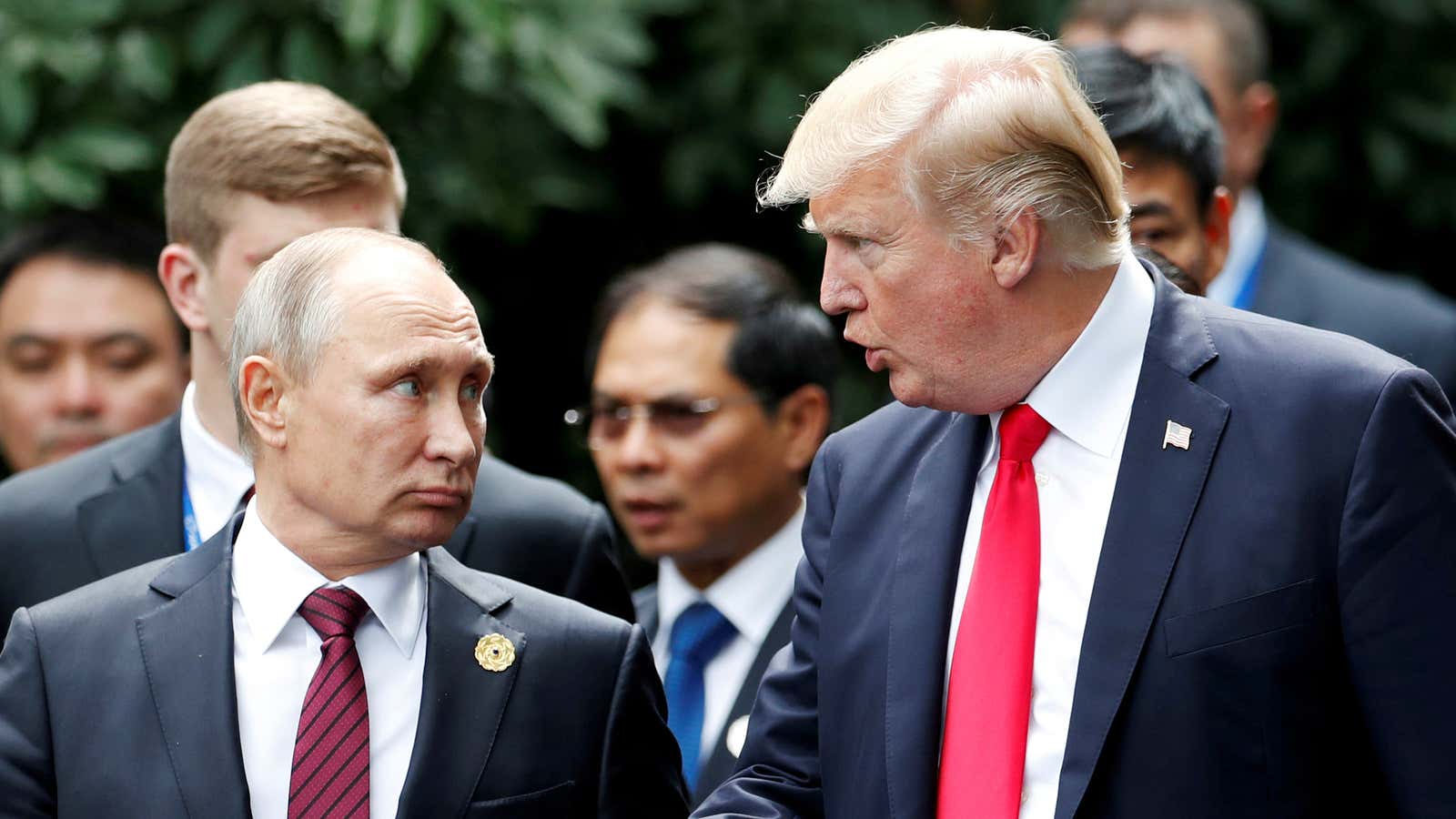Donald Trump and Vladimir Putin have a lot in common—elephantine egos, jowls, a post-fact approach to the world. They also happen to run two of the world’s most unequal countries, as major economies go.
The chart below shows the share of national income in three countries—the US, Russia, and France—claimed by the top 10% of earners since the early 1900s. (Income counts as wages, interest, rent, dividends, realized capital gains, pensions, and unemployment benefits before taxes and transfers.)
Elite earners in US, Russia, and France all claimed roughly the same share of income in the early 1900s. But their fortunes diverged dramatically over the next century. That makes it particularly striking that, in terms of income inequality, Russia and the US have wound up in about the same place.
Despite the global prominence of Russian oligarchs, you don’t often see Russia on the top of the income inequality charts. That’s probably because the government’s official data clearly understate the situation. These new data come from pioneering work by the French economist Thomas Piketty documenting more than a century of Russian wealth—trends that he details in a blog post and a fascinating new working paper.
By documenting the share of income pocketed by different ranks of earners, the measure tells us a lot about the distribution of wealth in a given society. For instance, in an egalitarian utopia, where everyone made just about the same amount of money each year, the top 10% of earners would earn only a bit more than 10% of total income.
But when that upper decile is bringing in, say, 48% of the country’s total income, it means that the average person in that top bracket is earning 4.8 times more than his average countryman.
And that, as it happens, is where the US finds itself as of 2015, the last year for which there are data. Elite Americans are now claiming the biggest share of income than they’ve managed in 75 years.
That’s probably no coincidence. It was around 75 years ago that New Deal reforms strengthening workers’ bargaining power began to bear fruit. Along with programs that boosted education and homeownership among World War II veterans, those reforms shifted wealth toward the middle chunk of society. That built the American middle class that powered a virtuous cycle of economic expansion. As the economy grew, so did incomes. And as consumption grew, so did the economy.
That “Great Compression” of incomes, as economists Claudia Goldin and Robert Margo termed it, ends abruptly in the 1980s as the US adopted neoliberal policies, shredding the New Deal social contract. (In Piketty’s home country, where a robust social welfare program endures, income remains far more equally distributed, though France’s economy has also grown at a slower pace.)
In terms of who earned what, Soviet Russia was strikingly—probably artificially—egalitarian. In 1980, the 10% highest Russian earners took home around 21% of total income, compared with around 46% in 2015. That’s almost exactly where it was in 1905, when czars ran Russia.
The country’s swift shift toward inequality begins with the Soviet Union’s collapse. Five years later, the share of income earned by the top 10% had almost doubled, jumping from 25% in 1991 to 48% in 1996, as a privatization bonanza got underway. Since then, that share has stayed in about the same place, ticking up during the epic Russian bull market that spanned from 1998 to 2008, and dropping just a tad after the global financial crisis and the plunge of oil prices.
The income grab by Russia’s elite as the country morphed from a Soviet republic to an (increasingly autocratic) kleptocracy was much sharper, and quicker, than that accompanying the US’s neoliberalist embrace.
But perhaps the circumstances and timing of the US shift should make Americans even more uneasy. Russia’s inequality is an unfortunate but unsurprising byproduct of the Soviet Union’s collapse; the epic upheaval that followed gave oligarchs an easy opportunity to seize control of the institutions that distribute wealth. The US shift toward inequality, by comparison, occurred during a period of near-idyllic stability. Unlike Russia, the re-jiggerings of US political and economic institutions to favor the wealthy weren’t by accident. They were deliberate, voter-approved choices.
